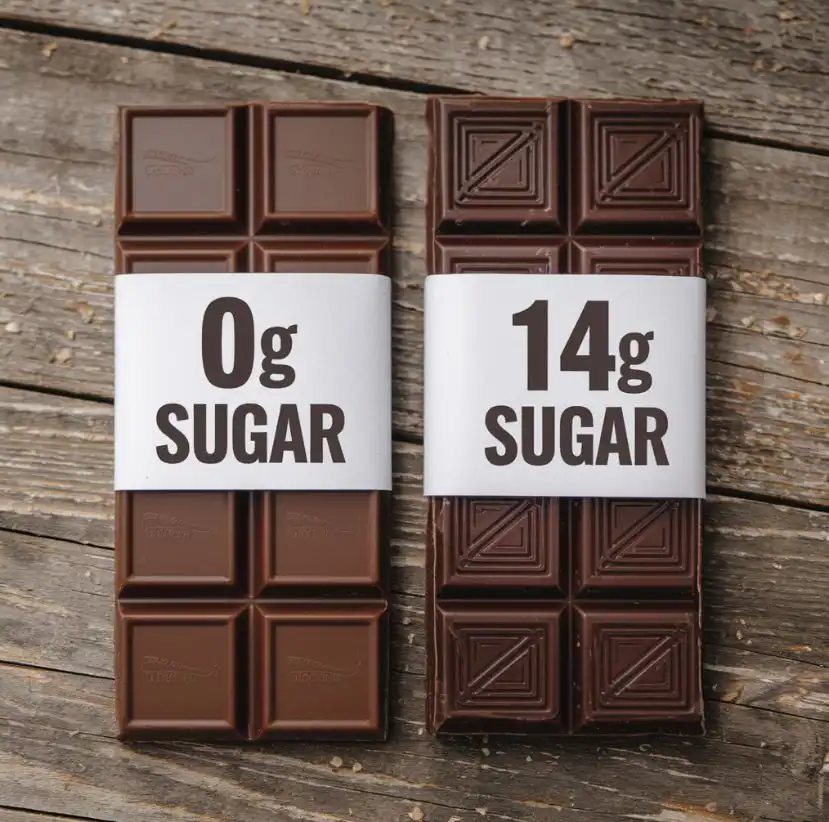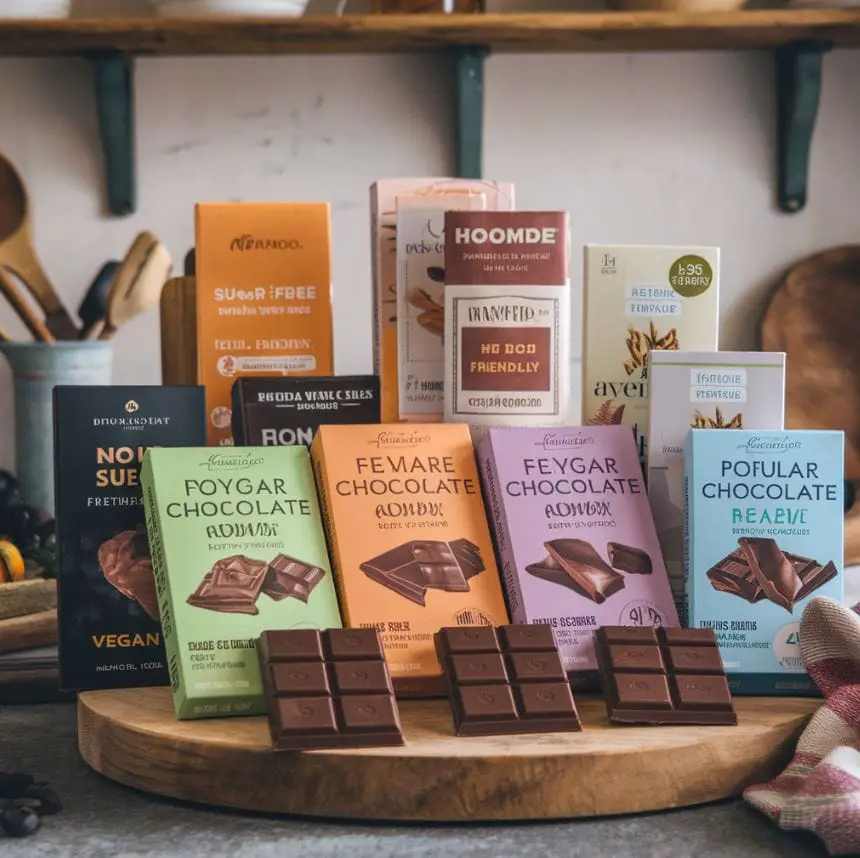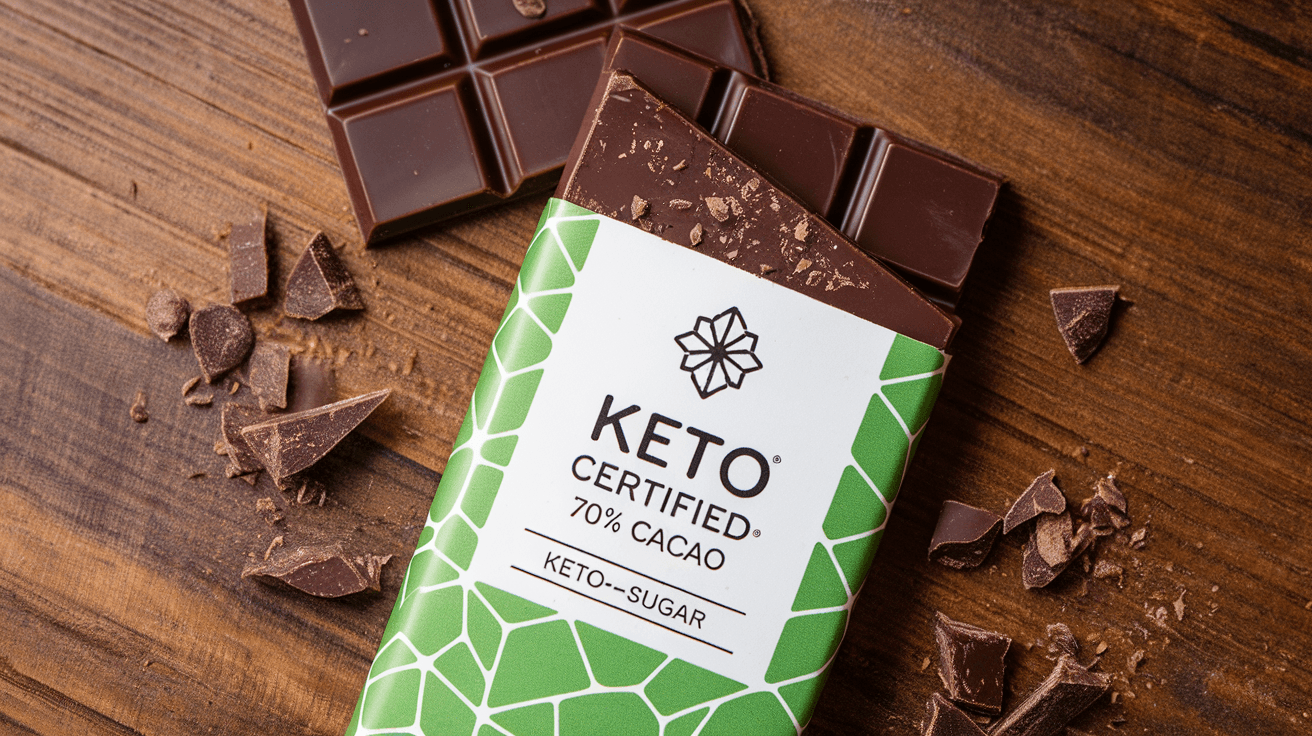In the world of confections, chocolate is undoubtedly one of the most beloved treats. However, for those mindful of their sugar intake, traditional chocolate can feel off-limits. Enter sugar-free chocolate—a game-changer that offers the same rich, decadent flavor without the unwanted sugar spike.
Sugar-free chocolate has gained immense popularity among health-conscious individuals, diabetics, and those pursuing low-carb or keto lifestyles. With its numerous health benefits and versatile applications, it’s no surprise that this healthier alternative is reshaping the chocolate industry. But what makes sugar-free chocolate different, and how can you incorporate it into your daily life?
In this guide, we’ll explore everything from its unique ingredients and health benefits to tips for choosing the best brands and even how to make your own delicious sugar-free chocolate at home. Whether you’re a curious first-timer or a seasoned chocolate enthusiast, there’s something sweet to discover.
Table of Contents
1. What is Sugar-Free Chocolate?
Sugar-free chocolate is a type of chocolate made without traditional refined sugars. Instead, it uses alternative sweeteners such as stevia, erythritol, monk fruit extract, or xylitol to provide sweetness without the high calorie and glycemic impact of regular sugar. This makes it a popular choice for those looking to enjoy chocolate while managing blood sugar levels, reducing calorie intake, or following specific diets like keto.
1.1 Ingredients
At its core, free chocolate retains many of the essential ingredients found in regular chocolate. These include:
- Cacao Beans or Cocoa Powder: The base ingredient responsible for the rich chocolate flavor.
- Sweeteners: Natural or artificial sugar substitutes like:
- Stevia: Derived from the stevia plant, offering a natural, calorie-free sweetness.
- Erythritol: A sugar alcohol with zero net carbs and a clean, sweet taste.
- Monk Fruit Extract: A fruit-based sweetener, known for being highly sweet without bitterness.
- Cocoa Butter: Adds creaminess and smooth texture to the chocolate.
- Milk Solids (for milk chocolate): For creamier variations.
- Emulsifiers (like lecithin): To ensure a smooth, consistent texture.
Why it’s unique: The lack of sugar doesn’t compromise the quality of the chocolate, but rather enhances its suitability for a variety of dietary needs.
1.2 How is it Different from Regular Chocolate?
While regular chocolate often contains significant amounts of added sugar to balance the natural bitterness of cacao, sugar-free chocolate uses healthier alternatives to achieve the same level of sweetness. Below is a comparison:
| Feature | Regular Chocolate | Sugar-Free Chocolate |
|---|---|---|
| Sweetener | Refined sugar, high fructose corn syrup | Stevia, erythritol, monk fruit, etc. |
| Impact on Blood Sugar | Causes spikes in blood sugar levels | Minimal to no impact on blood sugar |
| Calories | Higher due to added sugars | Lower because of alternative sweeteners |
| Diet Compatibility | Limited | Keto, diabetic-friendly, low-carb, paleo |

Sugar-free chocolate is not only healthier but also versatile, making it a perfect indulgence for those who wish to enjoy their favorite treat guilt-free. In the next section, we’ll delve into the health benefits of free chocolate and why it’s a smart addition to your lifestyle.
2. Health Benefits of Sugar-Free Chocolate
Free chocolate isn’t just a tasty alternative—it’s packed with surprising benefits for your health. Its nutrient-rich profile and lack of added sugars make it a standout choice for improving overall wellness without sacrificing flavor.
2.1 Better for Blood Sugar Levels
One of the most significant advantages of sugar-free chocolate is its minimal impact on blood sugar levels. Regular chocolate, loaded with refined sugars, causes rapid glucose spikes followed by energy crashes. In contrast, sugar-free chocolate, sweetened with alternatives like stevia or erythritol, offers a steady, more balanced energy release.
- Diabetic-Friendly: Ideal for individuals managing diabetes, as it helps prevent unwanted sugar surges.
- Glycemic Index: Most sugar substitutes used in these chocolates have a low to zero glycemic index, meaning they don’t cause significant glucose changes.
2.2 Supports Weight Management
For those looking to reduce calorie intake or follow a weight-loss plan, sugar-free chocolate can be a smart addition. Without the calorie-dense refined sugar, it helps satisfy sweet cravings while keeping your daily caloric intake in check.
- Keto and Low-Carb Friendly: No sugar chocolate aligns perfectly with low-carb or ketogenic diets. The absence of sugar makes it a guilt-free indulgence.
- Portion Control: A few squares of dark, no sugar chocolate provide a rich flavor, making it easier to feel satisfied with less.
Did You Know? Dark chocolate contains compounds like theobromine that naturally suppress appetite, helping you stick to your dietary goals.
2.3 Rich in Antioxidants
Cacao, the primary ingredient in chocolate, is loaded with antioxidants such as flavonoids. These powerful compounds combat oxidative stress, reducing inflammation and protecting your body from chronic diseases.
- Heart Health: Regular consumption of antioxidant-rich chocolate may improve circulation, lower blood pressure, and reduce the risk of heart disease.
- Skin Benefits: Flavonoids support skin health by increasing hydration, reducing UV damage, and promoting a youthful glow.
- Cognitive Support: Antioxidants in cacao are also known to boost brain health by enhancing focus and memory.
2.4 Gut-Friendly Properties
Some sugar substitutes like erythritol and inulin (a type of fiber) used in no sugar chocolate can act as prebiotics, promoting a healthy gut microbiome. A balanced gut helps improve digestion and boosts immunity.

2.5 Enhanced Mood and Stress Reduction
Chocolate, including sugar-free varieties, contains compounds like phenylethylamine (PEA) and serotonin precursors, which contribute to:
- Stress Relief: The act of savoring chocolate releases endorphins, the body’s natural feel-good hormones.
- Improved Mood: Dark chocolate consumption has been linked to lower levels of cortisol, a stress hormone.
Sugar-free chocolate doesn’t just taste great; it offers a variety of health benefits that make it a wise choice for everyday snacking. Up next, we’ll explore how to choose the best no sugar chocolate and avoid hidden pitfalls when shopping.
3. How to Choose the Best Chocolate
With so many free chocolate options on the market, selecting the right one can feel overwhelming. From understanding ingredient labels to spotting hidden sugars, choosing a high-quality product involves more than just picking the prettiest packaging. Here’s a guide to making an informed choice.
3.1 Reading the Label
The first step in identifying the best no sugar chocolate is examining the ingredient list. High-quality products should have a short, simple list featuring natural, recognizable ingredients.
- Key Ingredients to Look For:
- Cacao or Cocoa: The primary component should be cacao (or cocoa for processed versions), indicating a rich, chocolatey flavor.
- Natural Sweeteners: Opt for chocolates sweetened with stevia, monk fruit, or erythritol instead of artificial sweeteners like aspartame or sucralose.
- Cocoa Butter: Enhances creaminess and ensures a smooth texture.
- Vanilla or Natural Flavorings: Adds depth to the chocolate’s taste profile.
Pro Tip: Look for chocolate with a cacao percentage of 70% or higher for maximum health benefits.
3.2 Avoiding Hidden Sugars
Some chocolates marketed as “sugar-free” still contain ingredients that act as hidden sugars or high-calorie sweeteners. Here’s what to avoid:
- Maltitol: A sugar alcohol often used in sugar-free products but can still raise blood sugar levels and cause digestive discomfort.
- High-Fructose Ingredients: Watch for syrups or sweeteners that may be hidden under unfamiliar names like “agave syrup” or “brown rice syrup.”
- Low-Quality Fillers: Avoid chocolates with hydrogenated oils or unnecessary additives like artificial flavors.
Quick Tip: Products labeled as “no added sugar” are not always sugar-free. Check for naturally occurring sugars from milk or other ingredients.
3.3 Certifications and Labels
Certifications on the packaging can provide valuable insights into the quality and dietary compatibility of the chocolate. Look for:
- Keto-Friendly: Confirms low carbohydrate content.
- Diabetic-Friendly: Indicates suitability for managing blood sugar levels.
- Organic: Ensures no harmful pesticides or synthetic additives were used in production.
- Fair Trade: Reflects ethical sourcing of cacao and sustainable farming practices.

3.4 Taste and Texture
While health benefits are important, taste and texture make or break the experience. To find the most satisfying sugar-free chocolate:
- Trial and Error: Experiment with different brands to find your preferred balance of sweetness and bitterness.
- Dark vs. Milk Chocolate: If you enjoy rich, intense flavors, choose dark chocolate. For a creamier experience, opt for sugar-free milk chocolate.
3.5 Cost vs. Quality
High-quality sugar-free chocolate often comes with a higher price tag, but it’s a worthwhile investment for better taste and health benefits. Affordable options do exist but may compromise on sweetener quality or cacao content.
Budget-Friendly Tip: Buy in bulk or look for sales on trusted brands to save money without compromising quality.
By mastering the art of choosing free chocolate, you can indulge confidently and enjoy the numerous health benefits it offers. Up next, we’ll share simple and delicious recipes for homemade sugar-free chocolate treats.
4. Homemade No Sugar Chocolate Recipes
Making your own no sugar chocolate at home is a fun, cost-effective, and rewarding way to enjoy this healthier treat. You can customize ingredients, adjust sweetness, and experiment with add-ins to suit your taste. Below are three easy recipes to get you started.
4.1 Basic Sugar-Free Dark Chocolate
This simple recipe uses minimal ingredients for rich, flavorful chocolate that’s free of added sugar.
Ingredients:
- 1 cup unsweetened cocoa powder
- 1/2 cup coconut oil or cocoa butter
- 2-3 tablespoons erythritol or stevia (adjust to taste)
- 1 teaspoon vanilla extract (optional)
- A pinch of salt
Instructions:
- Melt the coconut oil or cocoa butter in a heatproof bowl over a saucepan of simmering water (double boiler method).
- Stir in the cocoa powder until smooth and lump-free.
- Add your sweetener, vanilla extract, and salt, stirring well to combine.
- Pour the mixture into silicone molds or a parchment-lined dish.
- Refrigerate for 1-2 hours until firm.
- Pop out the chocolate from the molds or slice into pieces and enjoy!
Optional Add-ins: Crushed nuts, shredded coconut, or free dried fruits for extra flavor and texture.
4.2 Truffles
These creamy, decadent truffles are perfect for special occasions or gifting.
Ingredients:
- 1 cup sugar-free dark chocolate chips
- 1/2 cup heavy cream or coconut cream (for a dairy-free option)
- 1 tablespoon unsweetened cocoa powder (for coating)
- Optional: A drop of peppermint extract or a sprinkle of sea salt for flavor
Instructions:
- Heat the heavy cream in a saucepan until it starts to simmer (do not boil).
- Pour the hot cream over the chocolate chips in a bowl and let it sit for 2 minutes.
- Stir the mixture until smooth and shiny.
- Let the chocolate ganache cool in the refrigerator for 1 hour until firm.
- Scoop small amounts with a spoon, roll them into balls, and coat with cocoa powder.
- Store in an airtight container in the fridge and enjoy chilled.
4.3 Keto-Friendly Chocolate Bark
This quick recipe combines sugar-free chocolate with crunchy, keto-friendly toppings for a satisfying snack.
Ingredients:
- 1 cup sugar-free chocolate (melted)
- 1/4 cup chopped nuts (e.g., almonds, walnuts, pecans)
- 1/4 cup unsweetened coconut flakes
- 2 tablespoons sugar-free dried cranberries or goji berries
- A pinch of sea salt
Instructions:
- Melt the sugar-free chocolate using the double boiler method.
- Pour the melted chocolate onto a parchment-lined baking sheet, spreading it evenly with a spatula.
- Sprinkle the nuts, coconut flakes, and dried berries over the chocolate.
- Finish with a light dusting of sea salt for flavor contrast.
- Refrigerate for 1-2 hours until the chocolate hardens.
- Break the bark into pieces and store in an airtight container.

Why Homemade?
- Control: You decide the ingredients and sweetness level.
- Cost-Effective: Save money by making gourmet-quality chocolate at home.
- Personal Touch: Add unique flavors or decorations to suit your preferences.
Now that you have these recipes, you can easily prepare sugar-free chocolate that rivals store-bought options. Coming up, we’ll discuss popular brands of sugar-free chocolate for when convenience is key.
5. Popular Brands of Sugar-Free Chocolate
If you’re short on time or prefer ready-made options, there are several high-quality free chocolate brands available that deliver both taste and health benefits. These brands cater to various dietary preferences, from keto-friendly to vegan options.
5.1 Affordable Options
For those on a budget, these brands provide delicious sugar-free chocolate without breaking the bank:
- Lily’s Sweets: Known for its wide range of sugar-free chocolate bars, baking chips, and confections, Lily’s uses stevia and erythritol for sweetness.
- Popular Products: Dark chocolate bars, salted almond milk chocolate, and baking chips.
- Why Choose It? Affordable, widely available, and keto-friendly.
- ChocZero: This brand specializes in no sugar alcohols chocolates, making it ideal for those with sensitive digestion.
- Popular Products: Sugar-free chocolate squares, chocolate bark, and syrups.
- Why Choose It? Clean ingredients, great taste, and versatile options.
Pro Tip: Look for deals or bulk purchase discounts online for these budget-friendly options.
5.3 Specialty Brands for Diabetics
Some brands focus on creating chocolates specifically tailored for diabetics or those with strict dietary restrictions:
- Russell Stover: Offers a wide variety of sugar-free candies and chocolate treats, sweetened with stevia and maltitol.
- Popular Products: Sugar-free peanut butter cups, toffee squares, and mint patties.
- Why Choose It? Perfect for portion-controlled indulgence.
- Good Sam: A newer brand offering ethically sourced, sugar-free chocolate sweetened with allulose.
- Popular Products: Milk chocolate bars and dark chocolate baking discs.
- Why Choose It? Low-calorie options with a smooth, creamy texture.

How to Choose Between Brands
- Taste Test: Different brands use varying sweeteners and cacao blends. Experiment to find your favorite.
- Diet Compatibility: Check for labels like keto, vegan, or paleo to match your dietary goals.
- Price vs. Quality: Affordable options work for everyday use, while premium chocolates are perfect for special occasions.
Sugar-free chocolate brands provide convenience and variety, ensuring there’s something for everyone. Whether you prefer budget-friendly bars or premium indulgences, these options make it easier than ever to enjoy chocolate without guilt.
6. FAQs About Sugar-Free Chocolate
Below are some frequently asked questions about no sugar chocolate to help address common concerns and curiosities.
6.1 Is sugar-free chocolate really healthier?
Yes, sugar-free chocolate can be a healthier alternative to regular chocolate, especially for those managing blood sugar levels, reducing calorie intake, or following specific diets like keto. By replacing refined sugar with natural sweeteners like stevia or erythritol, no sugar chocolate minimizes the negative impacts of sugar while retaining the health benefits of cacao, such as antioxidants.
Caution: Check the ingredient list to ensure the chocolate doesn’t contain high-calorie sugar alcohols like maltitol, which may negate its benefits.
6.2 Can kids eat sugar-free chocolate?
Yes, kids can enjoy free chocolate, but moderation is key. It’s a great option for reducing sugar consumption, especially if they have a sweet tooth. However, avoid chocolates with sugar alcohols like xylitol, which can cause digestive discomfort in some children.
Pro Tip: Always introduce new foods gradually and check for potential allergies or sensitivities.
6.3 Does sugar-free chocolate taste good?
Absolutely! Modern sugar-free chocolates are crafted using high-quality sweeteners and cacao, offering rich and satisfying flavors comparable to regular chocolate. While the taste may vary slightly depending on the sweetener used, most brands have perfected their recipes to ensure a delicious experience.
6.4 Is sugar-free chocolate safe for diabetics?
Yes, sugar-free chocolate is generally safe for diabetics, provided it uses sweeteners with a low glycemic index, like erythritol or stevia. These alternatives have little to no impact on blood sugar levels, making them suitable for managing diabetes.
Tip for Diabetics: Pair sugar-free chocolate with a high-protein snack to further stabilize blood sugar.
6.5 Does sugar-free chocolate have side effects?
While free chocolate is safe for most people, consuming large quantities can cause digestive issues, particularly if it contains sugar alcohols like maltitol or sorbitol. Symptoms may include bloating or mild laxative effects.
Solution: Stick to chocolates that use erythritol or stevia, as they are easier on the digestive system.
6.6 Can I use free chocolate for baking?
Yes, sugar-free chocolate is a fantastic option for baking! Many brands offer free chocolate chips, bars, and cocoa powder specifically designed for cooking. They work perfectly in recipes like cookies, brownies, or chocolate sauces without compromising taste.
Quick Tip: Add a small amount of natural sweetener, like monk fruit powder, if the recipe needs extra sweetness.
Sugar-free chocolate has carved out its space in the world of healthy eating, with options for everyone, from children to diabetics. It offers indulgence without compromise, answering many dietary concerns.
7. The Sweet Taste of Healthier Choices
Sugar-free chocolate proves that indulgence doesn’t have to come at the cost of health. Whether you’re seeking a guilt-free treat, managing blood sugar levels, or exploring low-carb alternatives, sugar-free chocolate offers a perfect balance of flavor and nutrition. With its diverse benefits—ranging from weight management and heart health to antioxidant power—it has earned its place as a modern-day superfood.
For those who enjoy creativity in the kitchen, homemade sugar-free chocolate recipes provide an exciting way to experiment with flavors and ingredients. And for convenience, a growing selection of trusted brands ensures there’s something for every palate and budget.
The key to enjoying sugar-free chocolate lies in making informed choices. Read labels carefully, avoid hidden sugars, and opt for natural sweeteners like stevia and erythritol. Whether you savor it as a snack, use it in recipes, or share it with loved ones, sugar-free chocolate lets you indulge without compromise.
So why wait? Explore the delicious world of free chocolate today and rediscover the joy of guilt-free indulgence. Your taste buds—and your health—will thank you.


6 thoughts on “10 Delicious Benefits and Recipes for Sugar-Free Chocolate”